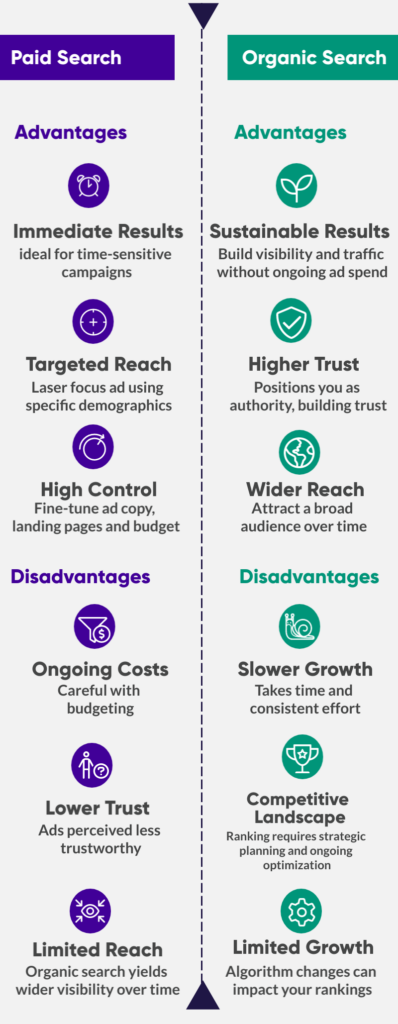Aligning Your Paid Search and Organic Search Marketing for Higher Education Enrollment Growth

Higher education marketing can feel like a constant battle for attention. Fewer potential students, global competition, and evolving needs make it tough to stand out. Rising costs and similar programs add fuel to the fire.
But there’s good news! Aligning paid search (targeted ads) with organic search (free website traffic) can be your secret weapon. This powerful combo attracts the right students, stretches your marketing budget, and can increase website traffic and conversions.
Think of it like this: paid search highlights your strengths, while organic search builds a welcoming landing page around them. Together, they create an irresistible package for students searching for the perfect educational fit.
So, how do we align these two strategies for maximum impact?
Take a deep dive into how to align your Paid Search and Organic Search efforts for maximum student enrollment growth.
What is Paid Search and Organic Search?

Before we dive into the power couple of paid and organic search, let’s define their roles.
Paid Search (PPC): Think of it as buying ads online. You target specific keywords, and whenever someone searches for those terms, your ad pops up, like a VIP ticket to the front row. Google Ads and Microsoft Advertising, including Bing Search are prime examples. You pay each time someone clicks on your ad, hence the “pay-per-click” name.
- Advantages:
- Immediate results: See traffic spikes quickly, ideal for time-sensitive campaigns or program launches.
- Targeted reach: Laser-focus your ads on specific demographics, interests, and even locations.
- High control: Fine-tune your ad copy, landing pages, and budget to maximize impact.
- Disadvantages:
- Ongoing costs: You pay for every click, so careful budgeting is crucial.
- Lower trust: Ads can sometimes be perceived as less trustworthy than organic results.
- Limited reach: Organic search often yields wider visibility over time.
Organic Search (SEO): This is where you build long-term visibility without paying directly. Imagine planting SEO seeds in your website content, nurturing them with relevant keywords and quality information. Over time, these seeds sprout into higher search engine rankings, attracting organic traffic naturally. It’s a marathon, not a sprint, but the results can be sustainable and cost-effective.
- Advantages:
- Sustainable results: Build long-term visibility and organic traffic without ongoing ad spend.
- Higher trust: Well-optimized content positions you as an authority, building trust with potential students.
- Wider reach: Organic rankings can attract a broader audience over time.
- Disadvantages:
- Slower growth: Building organic authority takes time and consistent effort.
- Competitive landscape: Ranking high for relevant keywords requires strategic planning and ongoing optimization.
- Limited control: Algorithm changes can impact your rankings, requiring adaptation.
Now, the magic happens when you combine these two forces! Here’s how they fuel each other’s success:
Paid Search drives targeted traffic: Use paid ads to reach specific audiences, searching for relevant keywords and directing them to your conversion-optimized microsite. This focused traffic increases the chances of conversion.
SEO research informs paid campaigns: Leverage keyword research from SEO to inform your paid search targeting and ad copy. This attracts qualified leads and gets you more results for your money.
Remember: Paid and organic search are not competitors but complementary partners. By understanding their strengths and weaknesses and harnessing their synergy, you can create a robust digital marketing strategy that attracts, engages, and converts students, ultimately driving enrollment growth for your institution.
Building an Aligned Strategy
1. Define your target audience:
Before diving in, paint a clear picture of your ideal student. Age, location, interests, and search habits – the more details, the better. This knowledge lets you create targeted messaging that speaks directly to their needs and aspirations.
2. Develop content that converts:
Personalization is key when it comes to creating high-quality content that resonates with your audience. With the help of AI tools and a lot of human oversight, you can tailor your message to fit the needs and interests of your ideal students, resulting in more meaningful interactions while aligning to your brand identity. Providing your prospective students with high-quality content not only improves the overall user experience but also increases the chances of pushing them further down the funnel.
3. Utilize targeting options:
Utilizing both paid search and organic search together will allow for better targeting and visibility in search engine results. One option is geo-targeting, where audiences are included based on their geographical location. This is especially useful for promoting programs that are only available in certain areas or targeting students from specific regions. Other targeting options include demographics, interests and behaviors, allowing you to narrow down your audience even further to reach the most relevant potential students.
By appearing in both paid and organic search results, you are showing potential students that you are a reputable and trustworthy source for their needs. Additionally, having a presence in both forms of search can help to reinforce your messaging and branding strategy.
4. Track and analyze performance:
Don’t just guess – track key performance indicators (KPIs) for both paid and organic campaigns. By continuously monitoring KPIs and making strategic adjustments, you can ensure that your campaigns are delivering the desired results and maximizing your impact in the competitive market. Consider the following KPIs for paid search and organic search:
- Click-Through Rate (CTR):
- CTR is a measure of how often people click on your ad or organic listing when they see it. It is calculated by dividing the total number of clicks by the total number of impressions (times your ad or listing was shown). A high CTR usually indicates that your ad or listing is relevant and appealing to users, which can lead to higher traffic and potential conversions.
- To improve your CTR, focus on creating compelling ad copy or optimizing your meta titles and descriptions for organic search.
- Average Cost-per-Click (CPC):
- CPC is the average amount you pay each time someone clicks on your ad. In paid search, this figure is influenced not only by your bidding strategy and quality score but also by the dynamics of the auction. Competitor bids play a significant role, as they can impact what we must pay to secure traffic. A lower CPC indicates that you’re garnering more clicks while spending less money, consequently enhancing your ROI.
- To reduce your CPC, consider improving the quality of your ads and landing pages to increase your quality score. You can also adjust your bidding strategy or target long-tail keywords that may have lower competition and lower CPCs.
- Conversion Rate (CR):
- Conversion rate measures the percentage of users who complete a desired action, such as filling out a form, after clicking on your ad or organic listing. It is calculated by dividing the total number of conversions by the total number of clicks.
- A high conversion rate indicates that your landing page and call-to-action are effective in convincing users to take action. To improve your conversion rate, make sure your landing page is relevant and optimized for the user’s search intent. You can also experiment with different calls-to-action or offers to see what resonates best with your audience.
- Cost-per-Inquiry(CPI):
- CPI measures the amount you pay on average for each inquiry. It is calculated by dividing the total cost of your campaign by the total number of inquiries received. A lower CPI means you are getting a higher return on your investment.
- To decrease your CPI, focus on improving your conversion rate and reducing your CPC. You can also optimize your targeting to reach a more relevant audience that is more likely to convert.
Remember, this roadmap isn’t a one-time trip. Continuously refine your approach and adapt to changing trends. You’ll be well on your way to unlocking enrollment growth through the power of aligned paid and organic search!
Benefits of Integrating PPC and SEO
Why Integrated PPC and SEO Make You an Enrollment Powerhouse?
Imagine dominating search engine results pages (SERPs) – grabbing top spots with paid ads while simultaneously securing strong organic rankings. That’s the double whammy you get with integrated PPC and SEO, leaving your competition scrambling. But the perks don’t stop there:
1. Reach Students at Every Stage:
Organic search lays the groundwork for building targeted remarketing lists. Leverage these lists with PPC to tailor your messaging based on specific student behaviors and interests. It’s like having a personalized roadmap to guide them on their journey to enrollment.
2. Unlock Keyword Gold:
Think of PPC as your keyword testing lab. Identify high-performing keywords that resonate with qualified students, then seamlessly incorporate them into your organic strategy. It’s like getting a sneak peek into the future of your SEO, guiding you towards maximum impact.
3. Amplify Your Brand Presence:
Forget shouting in a crowded room – combine paid and organic search to become the loudest voice in the digital space. Turn website visits into student applications by attracting interested prospects. Imagine your logo and message popping up everywhere they search, solidifying your institution as the go-to choice.
4. Supercharge Conversions:
PPC directs interested students straight to their own microsite, increasing the chances they’ll convert. It’s like having a warm welcome mat leading them from initial spark to enrolled student.
Don’t Just Play, Play Smart: Why Aligned PPC and SEO is Your Enrollment Game Changer
More than simply having a paid and organic search presence is required. To truly stand out and attract top students, you need alignment. Combining the laser focus of PPC with the long-term authority of SEO isn’t just a good idea; it’s the key to unlocking sustained enrollment growth.
This isn’t just theory; it’s a recipe for success. By aligning your paid and organic efforts, you can:
- Maximize visibility: Dominate search results pages, leaving competitors behind.
- Reach the right audience: Target students based on specific interests and behaviors.
- Boost brand awareness: Become the go-to choice for potential students.
- Supercharge conversions: Convert website visitors into enrolled students.
Ready to make your move? Don’t wait! Download our Organic Search Playbook for expert insights on optimizing your online presence. And for personalized messaging and content creation tips, grab our AI ebook. Together, let’s turn your digital marketing into a symphony of success, attracting top talent and driving enrollment growth for your institution.
Remember, the future belongs to those who play smart, not just play. So, start aligning your paid and organic search today, and watch your institution rise to the top of the class!